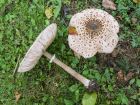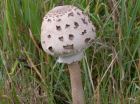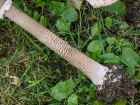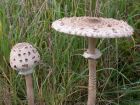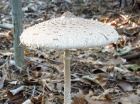Cap pallid brown decorated with darker brown broad scales. It starts off egg-shaped and then bell-shaped until the cap margin detaches from the stripe. The base colour becomes lighter with age. Dark scales appear on top when the brown surface cracks up from the smooth, central bump. The cap flesh is white and does not change significantly when cut. Gills white or pale cream, broad, crowded, free and terminating some distance from the stipe. Stem is distinctive grey-brown with banded markings on a whitish background, long and thin with an onion-shaped base. Above the double-edged ring that often falls off, it is evenly brown and below this, it is irregularly striped in a zigzag pattern. Spore print white or very pale cream.
Microscopic Features: The spores are ellipsoidal in shape, smooth, and have a thick wall. They measure approximately 12-18 x 8-12µm and possess a small germ pore.
Similar species include Chlorophyllum molybdites (The Vomiter) which has a stouter stalk and a greenish spore print.
Note: Multiple "parasol mushrooms" in North America may be identified as the Eurasian species Macrolepiota procera. Many, if not all, of these species are undescribed and unnamed.
Macrolepiota procera on the First Nature Web site.
Macrolepiota procera on the MushroomExpert.Com Web site.
Macrolepiota procera on the www.mushroomknowhow.com Web site.
The second and fourth photos are by Chrumps and licensed under the Creative Commons Attribution-ShareAlike 4.0 International license.
Many mushrooms are poisonous, and some can be lethally toxic. Distinguishing between edible and poisonous mushrooms can be very challenging. Therefore, we strongly advise against consuming wild mushrooms. This website does not contain any information about the edibility or toxicity of mushrooms.
Although efforts have been made to ensure accuracy on this website, the information may contain errors and omissions. Therefore, all content provided is for educational and informational purposes only and should not be relied upon or used as a basis for consuming any plants or mushrooms.
External links are provided for reference only. We do not endorse or take responsibility for the content, advice, or products found on these sites or in any advertisements shown on this website.
